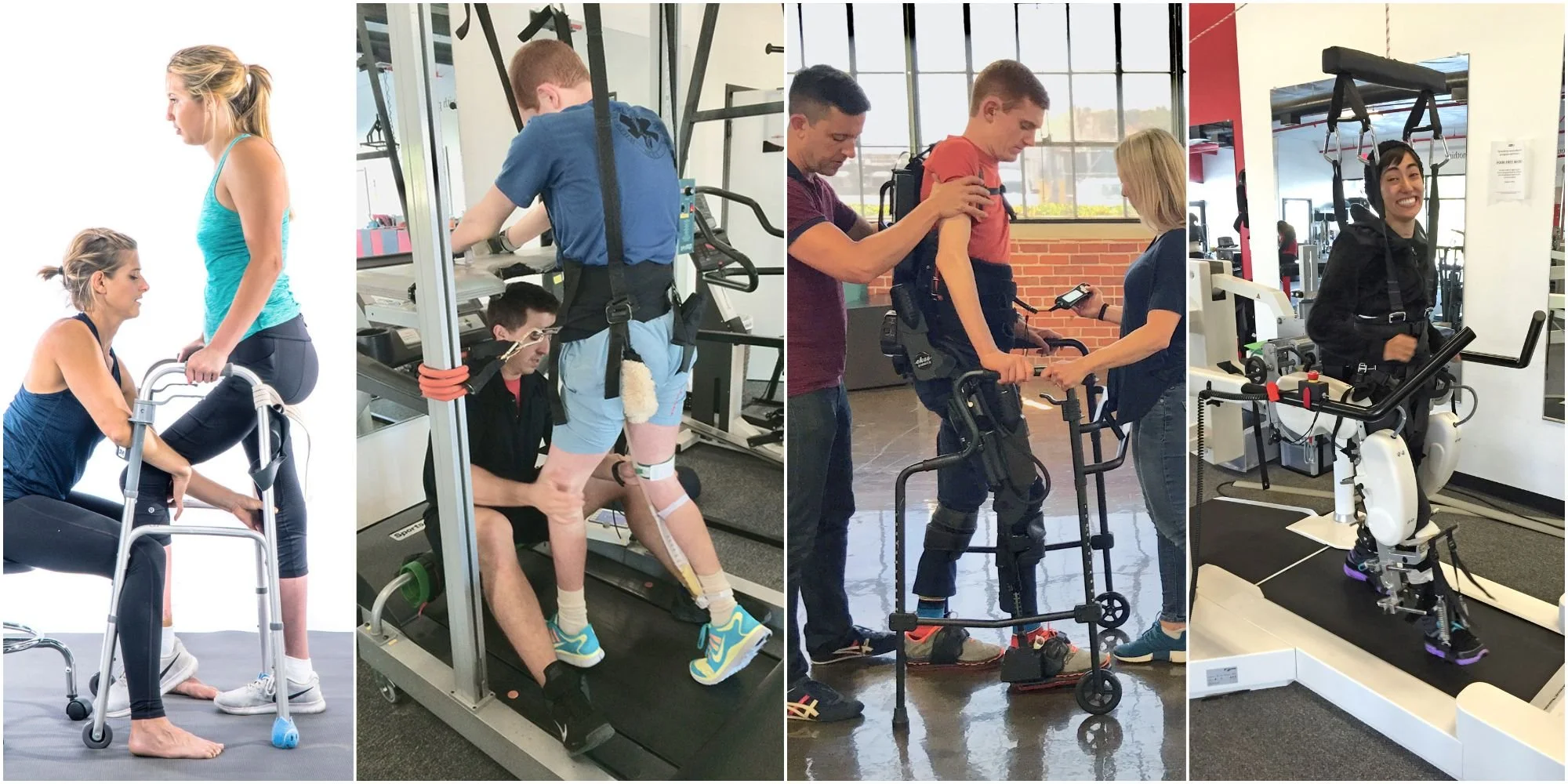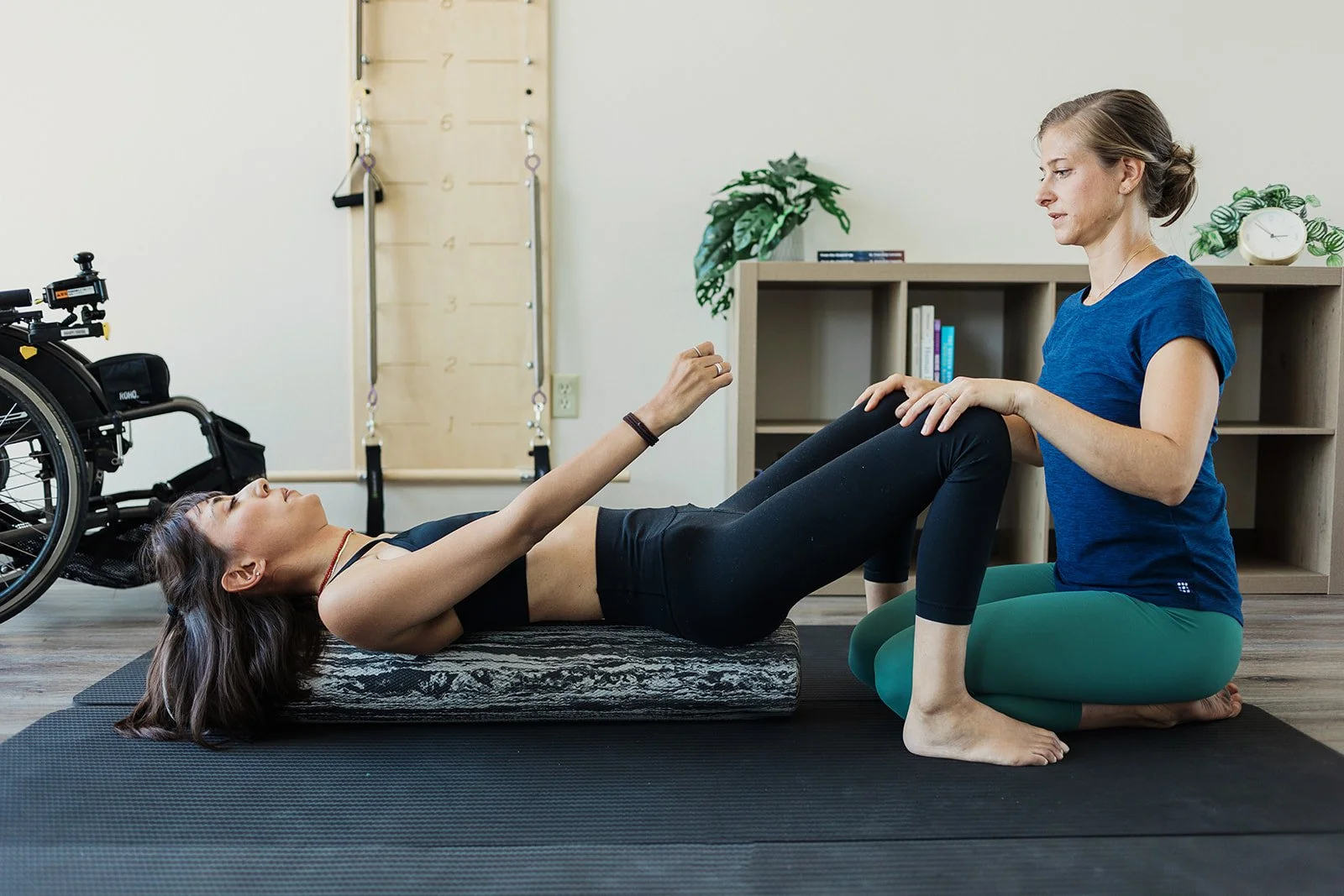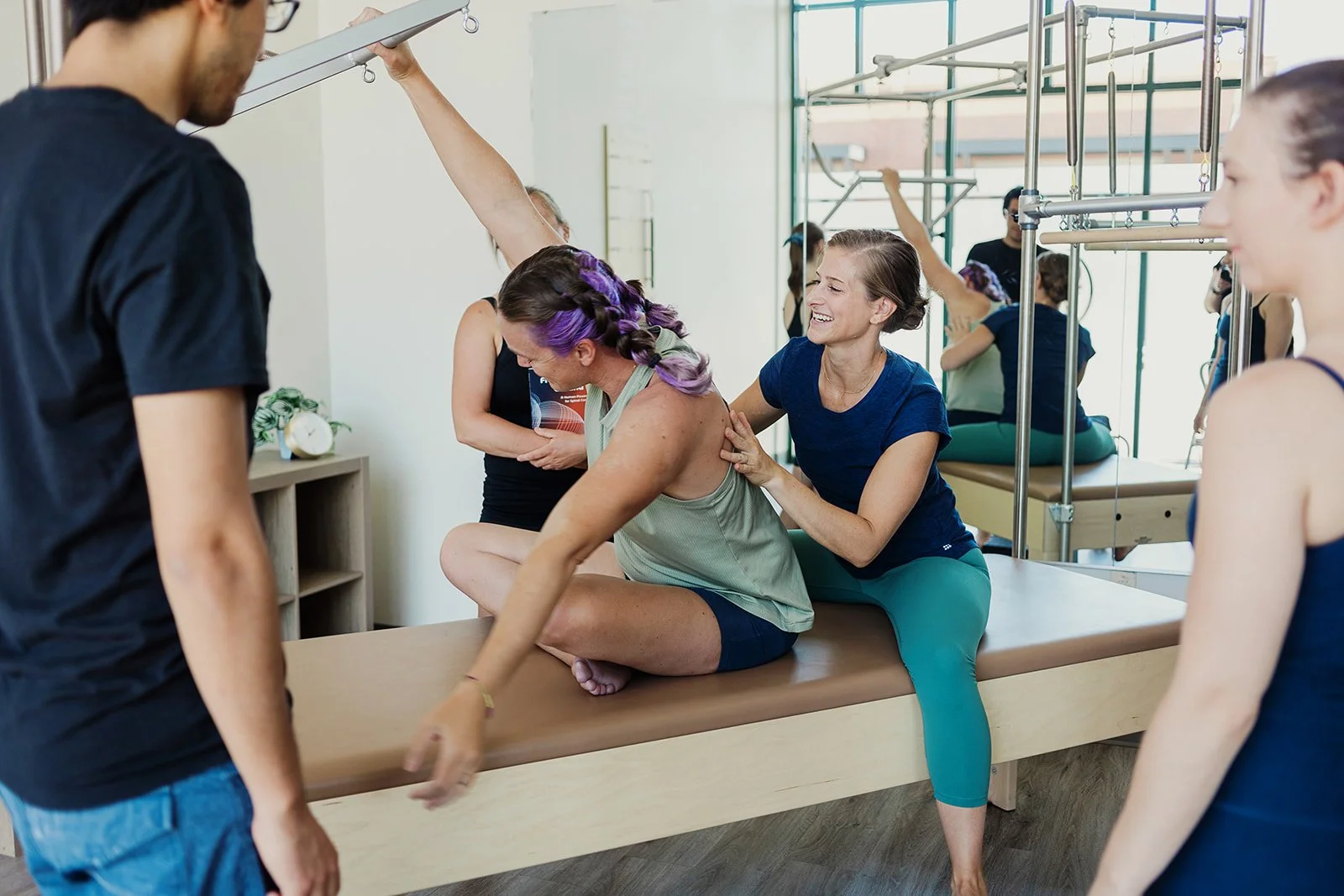Pilates for Spinal Cord Injury and Gait:
L1-4 SCI Client 6-week case study on pilates programming and effect on gait
Neuro rehab industry standard of gait training for spinal cord injury refers to the use of robotic suits and body-weight supported systems, either hoisted over treadmills or used overground with a ceiling track. With these modalities, either the robotic exoskeleton or a trainer/therapist moves the user’s legs through a gait-like pattern over thousands of repetitions per session.
There are many benefits to high repetitions of this kind of movement, but the SCI rehab community considers this one of the more effective ways to improve someone’s ability and quality of walking. For years, I went along with this idea. It made sense at the time: more walking = better walking, right?
Gait Training modalities, left to right: assisted overground with walker, assisted Body-Weight Supported Treadmill training (BWSTT), overground with robotic Eksoskeleton, treadmill with robotic Lokomat.
Over the first several years of my career in spinal cord recovery, I facilitated hundreds of hours of gait training sessions with a wide variety of clients. But for a lot of my clients, I felt that this kind of “gait training” was either:
Too passive: I was doing 99% of the movement in their legs & we would both get distracted in conversation during the mundane repetition.
Too advanced: gait has SO many components to it that need to sync together perfectly. Many clients didn’t even have the foundational mobility and/or strength for supporting their bodies in an upright postion let along locomotion.
Too rigid: Even if my client was able to ambulate some on their own, the harnesses and belts used in traditional gait training set-ups held the pelvis too tight to allow for the natural (essential!) rotation of the spine, pelvis and femurs.
With this logic, this approach didn’t seem to be the best way to improve someone’s gait function or quality… And this belief was backed up with the observation that even with 3-4x per week of gait training, most clients were NOT improving their gait.
What if “gait training” actually referred to the fine-tuning of the COMPONENTS of gait and the nuanced integration of those components (vs. just logging more steps)?
This would be things like:
Spinal extension
Core support in posture
Hip mobility, specifically hip internal and external rotation
Reciprocal patterns, like those also found in cross-over rolling drills and crawling
Independent tall sitting and kneeling
A little test of theory
I distinctly remember doing a “before-and-after” test with one of my more trusting clients: we did 5 minutes of assisted overground gait training, then some core connection work on a foam roller (see below), and then got back in the walker for another bout of gait training. She reported feeling stronger and more in control of her gait after her prep drills. Shocking, I know. *eye roll*
Since that revelation with Julia, I couldn’t look back. I started prepping my clients with core connection and hip mobility exercises before walking sessions, and even started spending more time on these components than we did in the walker. It seemed more and more that “gait training” is the exploration of gait components and the coaching of gait mechanics vs. session time spent walking.
Julia (C4 incomplete SCI) was one of the first clients I started playing around with different gait-prep drills with. This exercise - Head-Tail Foam Roller stability - helped her feel more connected in her gait training sessions.
A change of approach: from activity-based therapy principles to Pilates-style sessions
As I transitioned to a pilates-based approach, we found the support and feedback of the Pilates equipment was incredibly helpful for exploring these essential gait foundations. The bouncy feeling from springs resonated with the elastic recoil of our fascial and muscle tissues, and the focus on control and mechanics improved body awareness and integration.
I also turned to floor-based exercises inspired by the motor development progression to make sure that “all my i’s were dotted and t’s were crossed” on our way to advanced postures and exercises. Meaning, we were building the body’s mobility, stability, and coordination from the ground up, all the way to walking.
Proof in Pilates:
6-week case study
In 2020, I joined a case study project led by Elizabeth Larkam & Madeline Black where 30 Pilates teachers engaged in 6-week case studies and submitted their reports for a collaborative publication on the effects of Pilates programming on different health conditions like osteoporosis, Parkinson’s disease, Long COVID, etc.
Naturally, I studied one of my SCI clients and contributed the chapter on “Pilates and Spinal Cord Injuries: Effect on Gait.”
I chose one of my newer clients (we’ll call her Stacy for privacy) who had an L1-4 incomplete SCI. We started the study after only 5 private sessions with me, so she was still quite "green" when it came to pilates and deep healing.
The study called for 12 sessions over 6 weeks, with:
Session 1 = formal intake and review of health history
Session 2 = initial gait and movement analysis
Session 3 = review of home program exercises
Session 4-11 = Pilates foundations and “real” Pilates exercises
Session 12 = the final analysis
With those case study perimeters firmly in place, I only had eight in-person Pilates sessions to push my subject.
A short time to make big changes…
With only 6 weeks to make some big changes, I was torn between going straight to some of the “problem areas” vs. following the Framework I have developed, which emphasizes foundations but can often take a bit longer to see the “big changes.” Foundational work is an investment in the LONG game of process.
Ultimately, I decided to follow the Framework. I wanted a true representation of how I operate, and the case study would either prove or disprove its effectiveness.
About my subject
At the start of the study (summer 2020), Stacy primarily used a wheelchair when out and about but had started to use a walker or crutches around the house/in controlled settings.
Here’s what I documented during her initial gait analysis using Lofstrand Crutches and AFOs (ankle-foot-orthotics) that proved particularly important for programming decisions:
Relies on crutches for support and balance, especially during right stance phase.
Needs to look down during most steps for foot placement and confidence in weight bearing through legs.
Excessive scapular movement while moving and loading through crutches.
Minimal thoracic rotation relative to pelvis as observed by homolateral gait pattern.
Excessive right internal hip rotation during heel strike and stance phase.
Excessive lateral shift and pelvic rotation when transferring weight through stance.
Required 5 steps and a few hops to turn around during gait assessment.
You can find more information about this assessment on page 266 of Pilates Applications for Health Conditions, Volume 2.
This is not a how-to guide for your L1-4 SCI client.
This article will not cover the specifics of the program (you can read that in the actual publication!) but will share my thought process for program direction and exercise selection (as I recollect it 5 years later!). I aimed to write the blog as if I were thinking out loud, in real time, about my decisions.
These brainstorm-like notes are NOT included in the publication, but feel incredibly important for those looking to implement a similar program. I hope this article helps you consider your client cases with more strategic planning.
Case study programming:
My thoughts around exercise selection & sequencing for Stacey
Establish foundations in shoulder dynamics - even for a paraplegic
1. Efficiency with mobility aides
The shoulder girdle is the hip of the upper extremity.
When someone uses a weight-supporting mobility aide (like a walker or crutches), the person is essentially walking on all fours and the shoulder & hip girdle are responsible for force transmission through the core. Stacy was showing a lot of inefficiencies with the amount of scapular movement when she placed weight through the canes.
2. Leverage fascial lines
If we look at the fascial lines, particularly the Spiral and Functional lines, they serve an important role for reciprocal gait patterns. The shoulders provide a portal into the line and then support access to the rest of the line. Therefore, cleaning up shoulder dynamics would have a heavy influence on how well Stacy could leverage these lines for efficient reciprocal gait.
It can be tempting to overlook the shoulders in someone with a lower-level injury, since the shoulders are unaffected by the paralysis.
But for the reasons mentioned above, I almost always start with the shoulders no matter what the level of injury. And when I don’t start there, I usually have to double back because we hit roadblocks that would have been avoided if we just started at the top. Let this be a lesson to all: don’t skip the steps.
And so, we invested an entire session to shoulder mechanics and their interactions with core control. By the end of just the first session, we were (pleasantly) surprised at how much more upright and supported her gait looked and felt. Addressing shoulder mechanics was a very worthwhile investment in her overall program (with only 7 sessions left!).
Bring her back to mid-line
We started every session with an exercise for scapular control and its role in core stability. I was confident this general increase in core strength would improve her mid-line orientation, ultimately re-allocating the energy she was spending on a lateral shift into a more powerful FORWARD locomotion.
Stacy started with minimal hip abduction (demonstrated a classic Trendelenburg hip drop in stance). Traditional clamshells worked okay, but we found more success building strength in the lateral hip with:
Eccentric abduction exercises: controlled descent from quadruped to side sit.
Isometric abduction exercises: resisting lateral forces, like in a side plank.
Stance-specific exercises: lunge on Reformer or CoreAlign, standing leg pumps on the Chair - these are also great because the resistance is dynamic and requires reactive stability.
It was good evidence and a reminder for me to get creative with the approach in lateral hip stability - considering different angles, tempos, and types of activation.
Move through the Framework within each session, and over the course of the study
Using the Zebrafish Neuro Framework for Recovery, we progressed through exercises that improved Awareness, Connection and Integrated Patterns within each session.
In general, Awareness and Connection exercises are done in foundational positions like supine, side-lying and seated moving the legs through highly repetitive open-chained movements.
This category of exercises improves body awareness, proprioception and messaging, which is then integrated into functional patterns in the next phase of the Zebrafish Neuro Framework for Recovery.
Connection exercises in Stacy’s program included:
Supine Leg Springs (supported hip work)
Seated Leg pumps on the pilates chair (especially pressing into abduction)
At the beginning, these “Connection” exercises were a large chunk of the hour, and we would finish with a short standing sequence to pull it all together in the context of gait.
As the study progressed, we were able to spend less time “Connecting” in supine and seated exercises - using these exercises more like a warm-up - and more time “Integrating” in kneeling and standing exercises on the CoreAlign.
Home exercise program greatly accelerated progress
With the short length of the study, the home exercise program was essential for her progress.
Stacy engaged in her assigned home program 3 days per week in addition to daily stretching (30 minutes) and walks (15-30 minutes), with occasional stationary bike sessions (30-45 minutes).
Stacy’s assigned exercises started simple and the list was updated with progressions in Week 3.
Exercises included (with page numbers to exercise descriptions found in From The Ground Up):
Rotational knee drops
Supine 3D pelvis: pelvic clocks (FTGU, page 192)
Prone chest lift (“baby swan” or cobra) (FTGU, page 199)
Side elbow prop “plank” (FTGU, page 180)
Quadruped hip rotations
Kneeling chest expansion
Seated scooter (FTGU, page 233)
Standing lunge
Rotational knee drops
Quadruped hip rotations
Seated “scooter” from a chair + slider
What happened to Stacy after the study
“Stacy” and I continued to work together 2x per week for about 3 years. By summer 2022, she primarily used her Loftstrand crutches. One of our last sessions together was a hike with elevation and rocky terrain!
We learned so much from each other - and she continues to be a muse and reference for client programs ever since.
A Pilates-based approach to SCI rehab: put to the test
Pilates principles and the From The Ground Up Framework for Recovery were put to the test—and they delivered. I was thrilled to see Stacy’s program and progress unfold with literal textbook results.
Stacy’s story is just one example of how Pilates, when applied thoughtfully, can unlock progress where traditional gait training alone falls short. By breaking gait down into its essential components—core support, mobility, reciprocal patterns, and integration—we not only prepared her body for walking, but gave her the tools to walk with more efficiency, control, and confidence.
For Pilates teachers, this is a call to step into a space you might not have considered before: working with individuals navigating spinal cord injury. Your skills in observation, cueing, and building from the ground up are exactly what these clients need. And for neuro rehab professionals, it’s worth rethinking whether time in the walker is the only—or even the best—path forward. Pilates principles offer a powerful complement to traditional approaches, filling in the missing pieces that make gait not just possible, but sustainable.
For neurorehabilitation professionals, this highlights an important opportunity. While robotic systems and body-weight–supported treadmills offer high-repetition practice, they often bypass the preparatory building blocks that underlie efficient locomotion. Pilates-based programming offers a complementary pathway, one that enhances proprioception, optimizes motor control, and integrates movement patterns from the ground up.
The takeaway is simple:
Pilates isn’t just for the “able-bodied.” It has a rightful place in neuro rehab, and the sooner we integrate it, the more people we can help reclaim movement, independence, and joy in their daily lives.
Interested in learning more about how a
pilates-based approach (or pilates equipment)
can support a neuro-recovery program?
Click these links to find more information about my book and professional development courses!
About the Author of this Blog:
Stephanie Comella has been working with individuals with spinal cord injuries since 2011. She blends her formal education in movement science, Pilates, and other mindful movement modalities with neurological science to provide an intuitive, hands-on style of teaching focused on body re-connection. Stephanie aims to empower both individuals with SCI and their trainers using a human-powered healing approach.
















